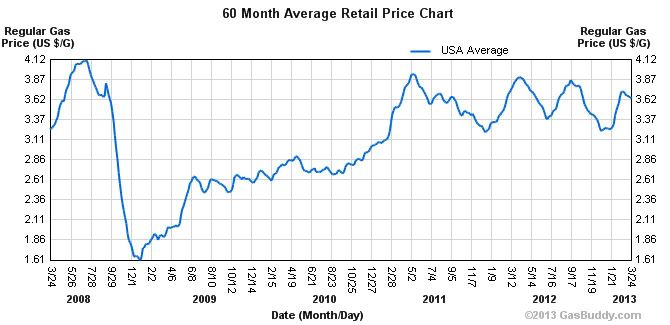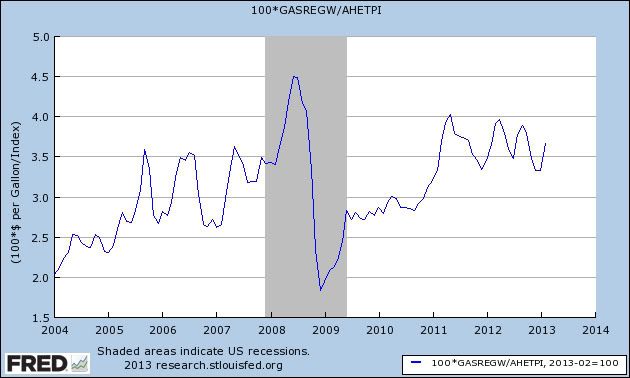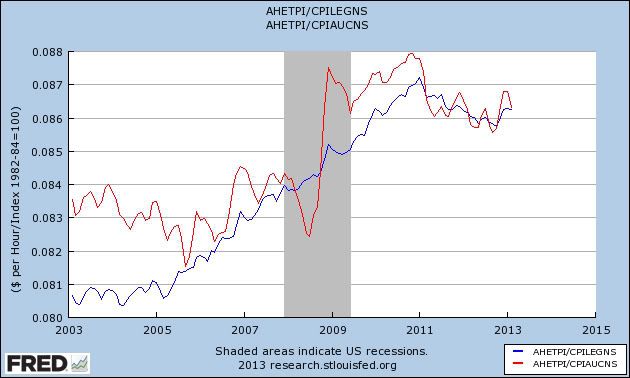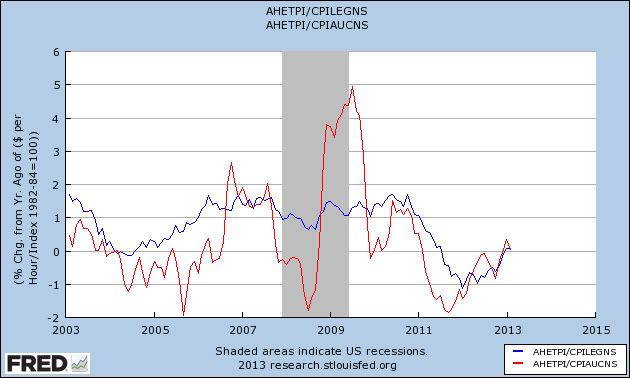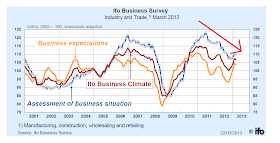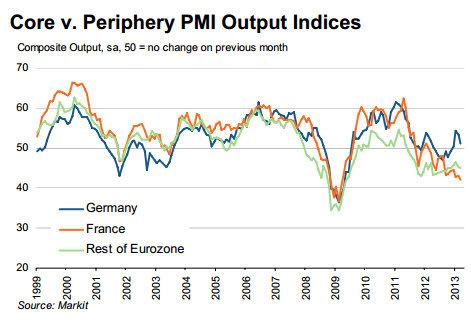- by New Deal democrat
Here is this week's look at data that gets reported on a high frequency, weekly basis. While it can be noisier than monthly or quarterly data, it has the virtue of being virtually up to the minute. Amplifications or reversals of trend will show up here before they show up in monthly data, which can already be two months old by the time they are reported.
In the rear view mirror, 4th quarter 2012 GDP was revised up slightly. Monthly data released in the past week included sharp increases in personal income, spending, and saving. Durable goods were up. The Chicago PMI became less positive. Consumer sentiment as measured by the Conference Board declined; as measured by the Univeristy of Michigan it increased. New home sales declined.
Let's start again this week's look at the
high frequency weekly indicators by checking what is happening with tax withholding, where we may finally have a reason for the awful YoY adjusted readings:
Employment metrics
Daily Treasury Statement tax withholding
- $151.0 B (adjusted for 2013 payroll tax withholding changes) vs. $156.0 B, -3.2% YoY for the last 20 days. The unadjusted result was $175.8 B for a 12.7% increase.
- $175.2 B was collected for the first 20 reporting days of March vs. $142.4 B unadjusted in 2012, a 23.4% increase YoY.
These are the best YoY comparisons in over two months, and the Thursday vs. Thursday 20 day comparison is up over 7% even on an adjusted basis. I've been saying that I see no reason why employment should have fallen off a cliff in January. A reader suggested that many employers may have been waiting until the end of the quarter to start making the increased payments, and that certainly looks like an explanation at this point. It'll take a few more weeks to be sure if that is so, or we just saw an anomaly this week.
Initial jobless claims
- 357,000 up 21,000
- 4 week average 343,000 up 3,250
American Staffing Association Index
- up 1 to 91 w/w up 2.4% YoY
Initial claims have established a new lower range of between 330,000 to 375,000 this year. In the last two years, beginning at the end of the first quarter there has been a spike of 20,000+ in jobless applications, and we may be seeing the beginning of that spike this week. The ASA is still running slighty below 2007, and slightly ahead of last year.
Consumer spending
Gallup has been very positive for 3 months. This week's YoY comparison is with the best spending week of the first half 2012, and was still up nearly 10%. The ICSC varied between +1.5% and +4.5% YoY in 2012. with one exception, the report for the last few weeks has been near the bottom of this range, and indeed was below that range this week. The JR report this week is at the top of its typical YoY range for the last year. Even in the worst case, it still looks like consumer spending has not collapsed due to the tax withholding increase.
Housing metrics
Housing prices
Housing prices bottomed at the end of November 2011 on Housing Tracker, and have averaged an increase of +2.0% to +2.5% YoY during 2012. This week remained slightly below the best YoY comparison in about 7 years.
Real estate loans, from the
FRB H8 report:
- up 1 or up less than +0.1% w.w
- up 4 or +0.1% YoY
- +2.1% from its bottom
Loans turned up at the end of 2011 and averaged about 1% gains YoY through most of 2012. In the last month these have stalled.
Mortgage applications from the
Mortgage Bankers Association:
- +7% w/w purchase applications
- +10% YoY purchase applications
- +8% w/w refinance applications
Purchase applications had been going sideways for 2 years. In the last couple of months they have finally broken out of that range - slightly - to the upside. Refinancing applications were very high for most of last year with record low mortgage rates, but did decreased recently with an increase of mortgage rates.
Interest rates and credit spreads
- 4.85% BAA corporate bonds down -0.06%
- 1.94% 10 year treasury bonds down -0.10%
- 2.91% credit spread between corporates and treasuries up +0.04%
Interest rates for corporate bonds have generally been falling since being just above 6% two years ago in January 2011, hitting a low of 4.46% in November 2012. Treasuries have fallen from about 2% in late 2011 to a low of 1.47% in July 2012. Spreads have varied between a high over 3.4% in June 2011 to a low under 2.75% in October 2012. The last several months have seen a marked increase in rates and credit spreads have widened.
Money supply
M1
- unchanged w/w
- -2.1% m/m
- +7.3% YoY Real M1
M2
- +0.2% w/w
- declined less than -0.1% m/m
- +4.7% YoY Real M2
Real M1 made a YoY high of about 20% in January 2012 and has generally been easing off since. This week's YoY reading remained above a new low set several weeks ago. Real M2 also made a YoY high of about 10.5% in January 2012. Its subsequent low was 4.5% in August 2012. In absolute terms, M2 made a high over 2 months ago and is down -0.5% from that peak. The behavior of M2 continues to bear close scrutiny.
Oil prices and usage
- Oil $97.07 up $3.36 w/w
- gas $3.70 down $0.01 w/w
- Usage 4 week average YoY +1.5%
The price of a barrel of Oil has backed off recent seasonal highs, and is actually down YoY. Unusually for the last year plus, the 4 week average for gas usage for the eighth week in a row was positive YoY. This may be due to winter weather having been actually winter-like this year.
Transport
Railroad transport from the
AAR
- +600 or +0.2% carloads YoY
- +2200 or +0.8% carloads ex-coal
- +3300 or +1.4% intermodal units
- +3600 or +0.7% YoY total loads
Shipping transport
Rail transport appears to have returned to its general trend from last year, but was just barely positive in all respects this week. The Harpex index remains slightly off its 3 year low of 352, and the Baltic Dry Index remains above its recent low.
Bank lending rates
The TED spread increased slightly from its 18 month+ low. LIBOR remained at its new 52 week low and is close to a 3 year low.
JoC ECRI Commodity prices
- up 0.12 to 128.09 w/w
- +3.24 YoY
Very few of the indicators are negative right now. Depending on the precise date of measurement, tax withholding may remain negative. Real estate loans have completely stalled. Bond yields are generally increasing and spreads widening.
But in general the weekly indicators have remained positive, but increasingly less so, over the course of the last month or so. Housing prices and mortgage applications remain very positive. Initial jobless claims are still positive even with the marked increase this week. Temporary staffing has turned more neutral though still weakly positive. Rail and shipping are also positive, but just barely so, as are commodities. Overnight bank lending rates remain somnolent.
As with last week, probably the brightest spots are consumer spending, still resilient in the face of the payroll tax increase, and gas prices, which are negative YoY and accomodative, and gas usage, which has been up YoY for several months.
The tone remains positive, but muted. Have a nice weekend.







